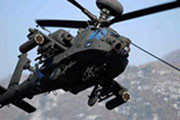
By Heather R. Smith
REDSTONE ARSENAL, Ala. (July 19, 2013) — In the future, Army aircraft may be made of all composite materials, and the Prototype Integration Facility (PIF) Advanced Composites Laboratory is ready.
Part of the Aviation and Missile Research Development and Engineering Center’s (AMRDEC), engineering directorate, the PIF’s advanced composites lab has successfully designed and made repairs on damaged composite aircraft components for several years now.
From research and development to implementation and rapid prototyping, advancing composites technology is one of AMRDEC’s core competencies that enable the current and future force.
The PIF advanced composites lab is one of several teams at the AMRDEC working with composites.
Composite materials are a combination of materials that, when combined, produce a new material with characteristics different from the individual components. Examples of composite materials are fiberglass, Kevlar, and carbon fiber. Composite materials may be preferred for many reasons, including increased strength, reduced weight, and reduced production and sustainment cost.
“We have gotten as strong and as light as we can get with metals, and we’re at the end of what metals can economically do,” PIF advanced composites lab lead Kimberly Cockrell said. “The only way to get stronger and lighter and more capable for the fight is to go to composites.”
PIF leadership recognized a need for advanced composites repair and began developing a composites capability within the PIF mission to provide rapid response solutions to the warfighter. The program includes repair design and engineering substantiation to show that repaired components are returned to original strength.
Personnel in the PIF advanced composites lab designed and developed repairs for damaged composite stabilators on the UH-60M Black Hawk helicopter and the AH-64E Apache helicopter. Prior to their repair method, the only way to repair an aircraft with a damaged stabilator was to pull off the broken stabilator and replace it with a new one.
Cockrell said the “pull-and-replace” approach was costing the Army up to six figures per stabilator replacement.
While the first repair procedures were designed for Black Hawk stabilators, the repair method applies to any solid laminate or sandwich core composite structure, so the procedures and training can be leveraged to other Army aircraft.
Cockrell is proud of the lab’s achievements. Its repair procedures are the first approved repair for primary composite structure on Army aircraft.
With integral support from the AMRDEC’s aviation engineering directorate, the procedures for the composite stabilator repairs have been written and are undergoing approval for release by the U.S. Army Aviation and Missile Life Cycle Management Command (AMCOM) logistics center.
An important aspect of developing repair methods is working with the repair personnel who will make the repairs. Members of the PIF Advanced Composites Lab have been training Soldiers on the new stabilator repair procedures prior to deployment so that they can request approval to use them, on a case-by-case basis, through the Aviation Engineering Directorate.
The lab has also trained the instructors at the 128th Aviation Brigade, as well as the AMCOM logistics assistance representatives.
In addition to training, the PIF Advanced Composites Lab, in partnership with the Aviation Engineering Directorate, played a lead role in developing the Army Technical Manual 1-1500-204-23-11 “Advanced Composite Material General Maintenance and Practices,” as well as in defining the tooling and material load for the new AVIM composites shop set.
The lab is currently working repairs for blades too, as well as just-in-time tooling for parts with complex curves or topography.
And in addition to repair solutions, the lab is using composite materials to create solutions for other issues. For example, it has designed and built a composite doubler to strengthen the hat channels that extend from the hinges of the UH-60 engine cowling.
“When the aircraft is on the ground being maintained, the engine cowling folds out to become a maintenance stand,” Cockrell explained. “Two Soldiers can stand up there with a tool box and work on the engine. Unfortunately, minor damage to those hat channels can cause these (cowlings) to catastrophically fail and seriously injure the Soldiers.”
“We designed this piece so that — if the hat channel shows any kind of damage whatsoever — you can simply install this doubler over the damaged area; it will restore the cowling to its original strength or better, and two doublers — one on each side of the cowling — adds less than a pound to the overall aircraft weight,” Cockrell continued. “So the pound that you add is well-worth the safety margin you gain.”
It’s concepts like that, Cockrell said, that the lab is introducing to program managers to show how the lab can help with more than just repairing stabilators.
“Our goal is to transition the stabilator repair business to other sources of supply, because we know that as soon as we get these repairs fully fielded, there will be new structures and composites issues for us to work,” Cockrell said. “The Apache composite tailboom, new composite cabin frames, new composite cabin floors, and new composite blades are all coming down the pike.”
“In five to 10 years, it’s all composite,” he said. “So whether it’s fiberglass or carbon fiber or Kevlar or a hybrid, it’s going all composite quickly. And it’s important for the Army to be ready.”
- AMRDEC is part of the U.S. Army Research, Development and Engineering Command, which has the mission to develop technology and engineering solutions for America’s Soldiers.
RDECOM is a major subordinate command of the U.S. Army Materiel Command. AMC is the Army’s premier provider of materiel readiness — technology, acquisition support, materiel development, logistics power projection, and sustainment — to the total force, across the spectrum of joint military operations. If a Soldier shoots it, drives it, flies it, wears it, eats it or communicates with it, AMC delivers it.







